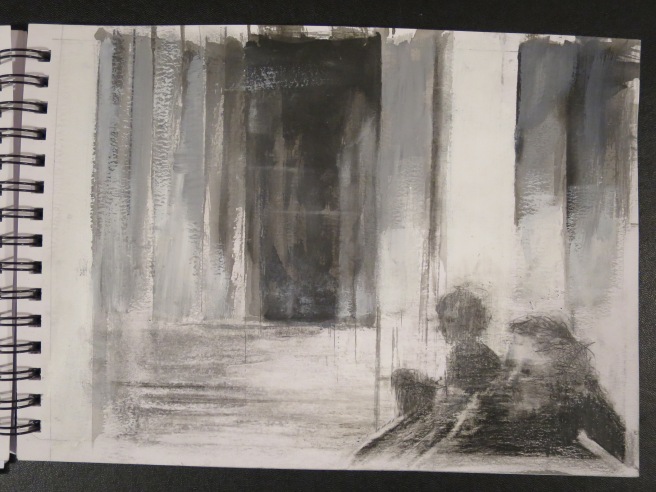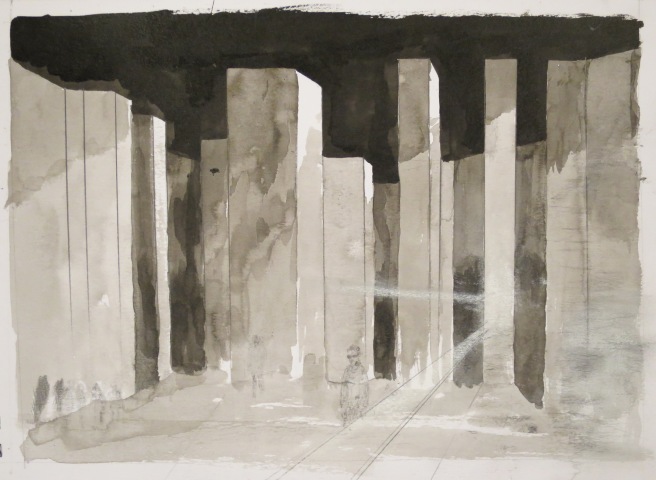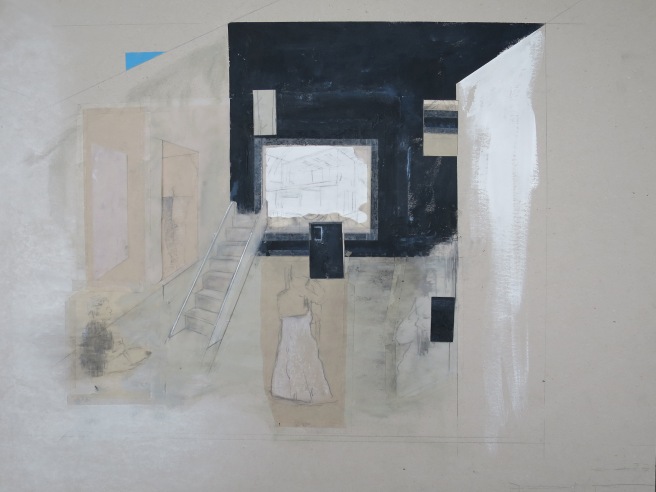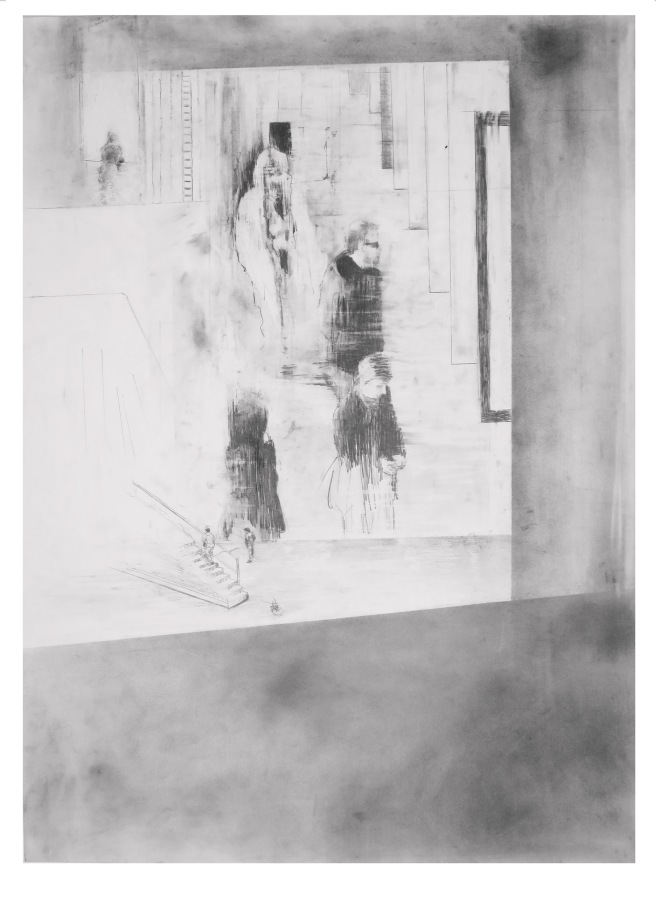21. Absence and collaboration
I think that all the art that I create is in some way collaborative. I am obtaining elements from a variety of sources and reconfiguring them, letting these be my guide. It is the unique juxtapositions that make it my own. Though the process is a collaborative one, sometimes psychic, across time. In this sense I think that perhaps all art is in some way collaborative. A collaboration of what has gone before, of time, psyche and history. My story is my own but it is part of the whole, part of a ‘total truth’ and part of the ongoing act of trying to understand the meaning of life (and death?).
‘A precipitating cause – in something unconscious that has joined them.’ Luc Tuymans on his use of source material/images.
The notion of stage design persists, as does the fascination with illusion within an artificially created world.
The structure becomes a façade that contains and leads to transportive, possibly otherworldly spaces. Defying the structure as the structure itself is in a state of collapse.
As I write this, my eldest is sat at the dining room table constructing a walled garden, which in turn contains a secret walled garden within. The secret garden includes a ‘backdrop’ of trees, suggesting that it continues out, whereas the vegetable garden that surrounds has no back drop/scenery.
Once again I am reminded of Lynch’s Inland Empire (2007): the half built wooded facades where Laura Dern’s character becomes lost amongst disturbed layers of reality. Parallels can be made here with Tarkovsky’s film Stalker (1979):
‘The thing about the Zone is that its always subtly reconfiguring itself according to your thoughts and needs.’ (Dyer, 2012)
‘In any magical realm there is always a deeper recess or chamber of more powerful magic.’ (Dyer, 2012)
This kind of space intrigues me. Firstly, I have to consider space…
Space is considered with reference to the stage designs of scenic designer Edward Gordon Craig (http://socks-studio.com/2014/02/15/to-transcend-reality-and-function-as-symbol-stage-design-of-edward-gordon-craig/ ) in a series of sketchbook drawings, using black ink and chalk…
More appropriation within a space using existing images, traced and reconfigured…
Moholy-Nagy – Use of space and appropriation…
In his take on Photomontage, Moholy’s Photoplastics (http://moholy-nagy.org/art/photoplastics/) combined his own photographs and found imagery with drawing to create striking visual compositions. Moholy cut and pasted and drew until a coherent image emerged.
What is evident is flow within an economy of space…
Moholy-Nagy, L Jealousy Photoplastic, 1925
…
Entrances and exits…Deaths and births…
Influenced by Moholy and affected by a recent Radiohead track/video (http://www.rollingstone.com/music/news/radiohead-release-stunning-daydreaming-video-ahead-of-new-album-20160506 ) and with a strange need to return to using purely pencil/graphite I created this drawing…
Dreamers, Pencil and graphite, 2016
A series of abstract and geometrical paintings and drawings created by the Russian artist artist El Lissitzky (https://monoskop.org/El_Lissitzky) between 1919 and 1927…
Imagine this (PROUN Series) as a minimalist, inter-changing stage set.
El Lissitzky, PROUN 1-C, 1919
El Lissitzky, PROUN The Bridge, 1920
PROUN is understood as the creative construction of form (based on the mastery of space) assisted by economic construction of the applied material…the builder consolidates them all together in his own experimental investigation…https://thecharnelhouse.org/2013/09/16/proun/
…
A few weeks ago I scrawled the words: Consider emptiness. Move away from complexity towards purity and simplicity.
Just as the scene in space switches to absolute silence, because of course: nothing can be heard in space, so too this happens for a moment in my work. I think that this comes through some kind of absence. The figure has disappeared for a while – it could be forever. Instead I am left with clues, the suggestion that a human presence once existed.
How did I dare to remove this aspect?
Weren’t the figures absent anyway?
That was the point.
Transparency.
Terra Firma Shift, Pencil and chalk on paper, 2016
Untitled/Unfinished, Pencil and acrylic on paper, 2016
In some way I would like to achieve this in my work…
Swans tunes are built like spiderwebs: delicate enough to blow on, yet surprisingly durable against wind and rain, elegant but dotted with gruesome shapes in a complex, shifting geometry. p://pitchfork.com/reviews/albums/21994-the-glowing-man/
…and I am thinking about this…
Yves Tanguy, Palace On Window Rocks, 1942
impossible spaces…impossible stages…












Leave a Reply